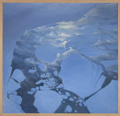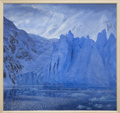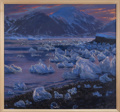This group of paintings features Sheridan Glacier, which is about an 18-mile drive from David’s home in Cordova. Over the years, he has spent countless hours hiking on the glacier and ice skating on the lake created by its retreat. From 1977 when he first saw Sheridan Glacier to 2022, the retreat comprises a loss of approximately 16 square miles of ice as much as 1,000 feet thick, which has broken up and melted into Sheridan Lake.
During David’s more than four decades observing glaciers, he has seen significant alterations in the landscape due to climate change. He also paints speculative views of glaciers of the past, how they may have looked before his arrival in Alaska in 1977 or even millennia earlier. There is an example of this in the stacked paintings just past the concrete column on the adjacent wall to your right, where you see the pairing of View from above the Copper River Flats from 2018 on the top, while the painting below depicts how David imagines that same geographic location would have looked around 13,000 BC.
David shares:
“As I witness the retreat of the glaciers at the end of the Ice Age, I am captivated by thoughts of glacial landscapes of the past. Anyone looking at the Copper River and its delta can see evidence that all these glaciers came together in one glacier that flowed toward the Gulf of Alaska, covering the Copper River and its delta. I have not found much scientific literature detailing the history of the Copper River Glacier, but as an artist, I can speculate about it. My imagination has led me to paint some glacier scenes from the past, including a series of recent and historical views of Childs and Miles glaciers.”
Please proceed to audio tour location 5.







